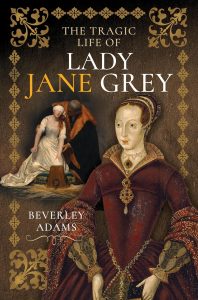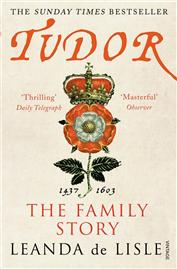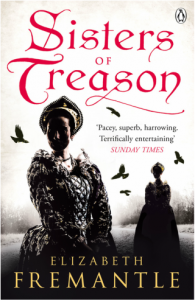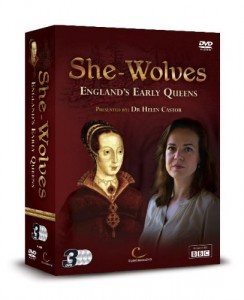I am delighted to host a stop on the blog tour to celebrate the publication of ‘The King’s Pearl: Henry VIII and His Daughter Mary’ by Melita Thomas.
Thank you to Melita for this guest article about the relationship between Mary and the Grey family.
Cousins, servants, friends – Mary and the Grey family
When her cousin, Lady Jane Grey, challenged Mary for the throne in 1553, pushed into it by her father, Henry Grey, Duke of Suffolk, and her father-in-law, the Duke of Northumberland, Mary was facing not just a fight for her crown, but also a deep sense of betrayal. Whilst the fact that Jane’s mother, Frances, was Mary’s first cousin, is well-known, much less familiar is Mary’s long history of friendship with Jane’s Grey family, who were also her relatives, descended from the first marriage of Mary’s great-grandmother, Elizabeth Woodville to Sir John Grey of Groby.
The Grey family had surrounded Mary almost from her birth. Thomas, 2nd Marquis of Dorset, was Henry VIII’s cousin, and despite a fourteen-year age gap, Henry was fond enough of him to forgive his disastrous leadership of a military expedition in 1512, which failed to re-establish English control in south-west France.
The 2nd Marquis had a brother, Lord Leonard Grey, and several sisters, amongst whom were Lady Elizabeth and Lady Anne, who both served Henry VIII’s sister, the first Mary Tudor, during her tenure as Queen of France. Lady Anne continued in her service, whilst Lady Elizabeth (later Countess of Kildare) transferred to that of Katharine of Aragon. It was Lady Elizabeth who stood as proxy for Mary when the princess was chosen as godmother to the French Queen’s daughter, Frances Brandon. The cousins were only seventeen months apart in age, and Mary frequently visited Frances and her brothers during her childhood.
By his second wife, Margaret Wotton (painted by Holbein), the 2nd Marquis of Dorset had at least seven children, of whom several were Mary’s friends or in her household. The Marquis himself was named as Grand Steward of her Household when she went to the Marches of Wales in 1525, but it seems to have been an honorary title whilst his daughter, Lady Katherine, actually accompanied Mary. Lady Katherine remained with the princess until her household was broken up in 1533. By then, Katherine was Lady Maltravers (Lady Maltravers did not die in 1532, as Wiki suggests – she had three children in the late 1530s, dying probably in 1542).
Another of Mary’s favourite attendants in her early household was Mary Browne, who later married Lord John Grey, the 2nd Marquis’ son, whose brother, Lord Henry, was to marry Frances Brandon.
During the years of the annulment, the Greys, like most of the court, had mixed feelings, but usually put their loyalty to the king first. The 2nd Marquis died in 1530, leaving his son, thirteen-year-old Henry, to inherit as a minor. For the next ten years, Henry, now 3rd Marquis and his mother quarrelled incessantly about money. Perhaps as a counter to his mother’s public support for the Boleyn marriage (she stood as godmother to Elizabeth) Henry, like his aunt, Elizabeth, Countess of Kildare, was, according to the Imperial Ambassador, Chapuys, a supporter of Katharine’s. In early 1536, Lady Kildare and Marquis Henry attended a dinner party with Chapuys. The talk was all of the quarrel between Anne Boleyn and Cromwell, which pleased the diners immensely.
Lady Kildare’s support for Katharine may have been born, not just of her previous service to the queen, but from anger against the king at the loss of her husband, whom she had married for love, against the wish of her family. The Earl of Kildare, having been Lord Deputy of Ireland, became deeply embroiled in the complexities of Irish politics, and was replaced. He was arraigned for treason in 1534, but died in the Tower, before he could be either tried or freed.
All Mary’s attendants had been dismissed in December 1533, and for three years, she was almost friendless in the household of her half-sister, Elizabeth. But in 1536, after the execution of Anne, and when she herself had been forced to accept the annulment of her parents’ marriage, she was permitted to choose her own attendants. She selected only three, leaving the rest of the choices to the king and Cromwell. Amongst the three was Mary Browne, not yet married to Lord John Grey.
In the following years, Mary’s account books contain numerous references to the Greys. One of the earliest, in 1536, notes a tip to Lady Kildare’s servant for bringing a gift from the Countess, presumably pleased that Mary was now in favour again. The following year, Lady Kildare’s step-son, known as Silken Thomas, and his five uncles, rose up in rebellion. The king sent Lord Leonard Grey to Ireland to curb the rebellion – Lord Leonard promised his sister’s step-son that he would be unharmed if he surrendered. But all were executed. Lady Kildare’s own son escaped to the continent, for which her brother was blamed, and accused of treason, was himself executed in 1541. During Mary’s own reign, Lady Kildare’s son was restored to his earldom.
At the New Year of 1538, Mary tipped the servants of Lady Kildare and Lady Margaret Grey for bringing gifts. Lady Margaret Grey was now amongst Mary’s attendants and on Twelfth Night, 1538, they played cards together, Mary starting out with the sum of 20s – although we don’t know how much she ended the evening with. Lady Kildare gave the princess a comb-case worked with pearls as a New Year gift in 1541, whilst her niece, Lady Anne Grey, gave artificial flowers.
In 1543, Lady Margaret sent the princess a cheese. She followed this up with the gift of a partlet (short wrap covering the upper arms, worn over the gown). Mary reciprocated with a present of two sovereigns. The next year, Lady Margaret and Lady Anne Grey gave Mary gifts of conserve (jam). Mary loved fruit of all kinds, so the delivery of jam in November, was probably a much-appreciated treat. That New Year of 1544, Mary also received gifts from her cousin, Frances, Marchioness of Dorset, and Lady John Grey.
During the later years of Henry VIII’s reign, Frances Dorset was often with Mary, although, as a married woman, with a family of three daughters, she was not always at court. But over time, religion began to come between the Greys and Mary. Henry, 3rd Marquis, became an ardent reformer, and brought his daughters up as evangelical Protestants.
With these familial connections, and old friendships, it must have been hard for Mary to bear the betrayal by Henry Grey, now Duke of Suffolk, in 1553 and it was probably her affection for his family, as well as for Frances, that led her to pardon him. His treasonable involvement with Wyatt’s Rebellion, in 1554, along with his brothers, Lord John and Lord Thomas, proved impossible to forgive, and Suffolk and Lord Thomas ended on the block. Lord John had cause to thank his lucky marriage – his wife pleaded for him, and Mary, remembering a friendship first forged in 1525, forgave him. His niece, Jane, was not so fortunate.
Whilst the daughters of Henry, Duke of Suffolk, Lady Jane, Lady Katherine and Lady Mary all suffered for their closeness to the throne, the rest of the family prospered. The current royal family is descended not only from Lady Katherine Grey, via the late Queen Elizabeth the Queen Mother, but the late Diana, Princess of Wales, is a descendant of the Lady Anne Grey who sent Mary the jam in 1544.
Mary and the Greys Family Tree
Grey Royal Descendants Family Tree
Other stops on the The King’s Pearl blog tour.
Buy ‘The King’s Pearl’:
Amazon.co.uk
Amberley Publishing
About the Author
Melita Thomas is the co-founder and editor of Tudor Times, a repository of information about Tudors and Stewarts in the period 1485-1625 www.tudortimes.co.uk .
Melita has loved history since being mesmerised by the BBC productions of ‘The Six Wives of Henry VIII’ and ‘Elizabeth R’, when she was a little girl. After that, she read everything she could get her hands on about this most fascinating of dynasties. Captivated by the story of the Lady Mary galloping to Framingham to set up her standard and fight for her rights, Melita began her first book about the queen when she was 9. The manuscript is probably still in the attic!
Whilst still pursuing a career in business, Melita took a course on writing biography, which led her and her business partner, Deborah, to the idea for Tudor Times, and gave her the inspiration to begin writing about Mary again.
Follow Melita and the Tudor Times on Social Media
Tudor Times: Tudor Times
Facebook: Tudor Times
Twitter: @thetudortimes








































